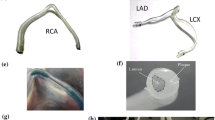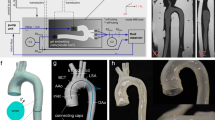Abstract
Our objective was to evaluate methodological aspects of impedance planimetry, a new balloon catheter-based technique, for the investigation of coronary artery mechanical wall properties. We used a four ring-electrode electrical impedance measuring system that was located inside a balloon. Two of the electrodes were used for excitation and connected to a generator producing a constant alternating current of 250 mA at 5 kHz. The other two electrodes for detection were placed midway between the excitation electrodes. The balloon was distended with electrically conducting fluid through an infusion channel. The vessel cross-sectional area (CSA) was measured according to the field gradient principle by measuring the impedance of the fluid inside the balloon. Impedance planimetry was applied in the three major branches of the coronary arteries of seven extracted porcine hearts to assess luminal CSAs in response to internal pressurization. The biomechanical wall properties were evaluated by computing the strain [(r−r 0)·r 0 −1, wherer is the vessels inner radius computed as (CSA · π−1)½ andr 0 is the radius of the vessel at a minimal distension pressure], the tension [(r·dP), wheredP is the transmural pressure difference], and the pressure elastic modulus (ΔP·r·Δr −1). We found thatin vitro testing demonstrated that impedance planimetry was accurate and reproducible. The technique has controllable sources of crror. Measurements were performed with consecutively increasing pressures in the range 1–25 kPa (8–188 mmHg, 0.01–0.25 atm). The CSAs increased nonlinearly and were significantly larger in the left anterior descendent coronary artery (LAD) (1 kPa, mean 5.0 mm2; 25 kPa, mean 21.8 mm2) than in both the left circumflex (Cx) (4.5–16.0 mm2) and the right coronary artery (RCA) (2.8–15.6 mm2) (analysis of variance,P<0.001 for both). The circumferential wall tension-strain relation showed exponential behavior. For a given strain, tension values for LAD were significantly lower than those of Cx (P<0.01). The pressure elastic modulus-strain relation also was exponential, and values for Cx were significantly lower than values for LAD (P<0.001) and RCA (P<0.05). Impedance planimetry was applied to the study of coronary artery biomechanicsex vivo. The LAD had the largest CSA, and the Cx was the least compliant. Methodological aspects of anin vivo introduction of the method require additional evaluation.
Similar content being viewed by others
References
Alfonso, F., C. Macaya, J. Goicolea, R. Hernandez, J. Segovia, J. Zamorano, C. Bañuelos, and P. Zarco. Determinants of coronary compliance in patients with coronary artery disease: An intravascular ultrasound study.J. Am. Coll. Cardiol. 23:879–884, 1994.
Ardissino, D., S. Di Somma, J. Kubica, P. Barberis, P. A. Merlini, E. Eleuteri, S. De Servi, E. Bramucci, G. Specchia, and C. Montemartini. Influence of elastic recoil on restenosis after successful coronary angioplasty in unstable angina pectoris.Am. J. Cardiol. 71:659–663, 1993.
Bergel, D. H. The properties of blood vessels. In:Biomechanics: Its foundations and objectives. Englewood Cliffs, NJ: Prentice-Hall, 1972, pp. 105–139.
Botas, J., D. A. Clark, F. Pinto, A. Chenzbraun, and T. A. Fischell. Balloon angioplasty results in increased segmental coronary distensibility: A likely mechanism of percutaneous transluminal coronary angioplasty.J. Am. Coll. Cardiol. 23:1043–1052, 1994.
Cox, R. H. Passive mechanics and connective tissue composition of canine arteries.Am. J. Physiol. 234:H533-H541, 1978.
Cox, R. H. Mechanical properties of the coronary vascular wall and the contractile process. In: The coronary artery. London: Croom Helm Ltd., 1982, pp 59–90.
Dixon, W. J. BMDP statistical software manual. Los Angeles: University of California Press, 1992, 1499 pp.
Dobrin, P. B. Mechanical properties of arteries.Physiol. Rev. 58:397–459, 1978.
Dupouy, P., H. J. Geschwind, G. Pelle, D. Gallot, and J. L. Dubois Rande. Assessment of coronary vasomotion by intracoronary ultrasound.Am. Heart J. 126:76–85, 1993.
Farrar, D. J., H. D. Green, W. D. Wagner, and M. G. Bond. Reduction in pulse wave velocity and imporvement of aortic distensibility accompanying regression of atherosclerosis in the rhesus monkey.Circ. Res. 47:425–432, 1980.
Fung, Y. C.Biomechanics: motion, flow, stress, and growth. New York. Springer-Verlag, 1990, 569 pp.
Gow, B. S. Circulatory correlates: vascular impedance, resistance, and capacity.Handbook of physiology. Bethesda, MD: American Physiological Society, 1980, pp. 353–408.
Gow, B. S., and C. D. Hadfield. The elasticity of canine and human coronary arteries with reference to postmortem changes.Circ. Res. 45:588–594, 1979.
Gregersen, H., and M. B. Andersen. Impedance measuring system for quantification of cross-sectional area in the gastrointestinal tract.Med. Biol. Eng. Comput. 29:108–110, 1991.
Gregersen, H., K. Kraglund, and J. C. Djurhuus. Variations in duodenal cross-sectional area during the interdigestive migrating motility complex.Am. J. Physiol. 259:G26-G31, 1990.
Gregersen, H., K. Orvar, and J. Christensen. Biomechanical properties of duodenal wall and duodenal tone during phase I and phase II of the MMC.Am. J. Physiol. 263:G795-G801, 1992.
Gregersen, H., H. Stodkilde Jorgensen, J.C. Djurhuus, and S. O. Mortensen. The four-electrode impedance technique: a method for investigation of compliance in luminal organs.Clin. Phys. Physiol. Meas. 9 Suppl A:61–64, 1988.
Harris, J. H., E. E. Therkelsen, and N. R. Zinner. Electrical measurements of ureteral flow. In:Urodynamics. London. Academic Press, 1971, pp. 465–472.
Iseri, L. T., and J. H. French. Magnesium: nature's physiologic calcium blocker.Am. Heart J. 108:188–193, 1984.
Lee, R. T., and R. D. Kamm. Vascular mechanics for the cardiologist.J. Am. Coll. Cardiol. 23:1289–1295, 1994.
Lose, G., H. Colstrup, K. Saksager, and J. K. Kristensen. New probe for measurement of related values of cross-sectional area and pressure in a biological tube.Med. Biol. Eng. Comput. 24:488–492, 1986.
MacAlpin, R. N., A. S. Abbasi, J. H. Grollman, Jr., and L. Eber. Human coronary artery size during life. A cinearteriographic study.Radiology. 108:567–576, 1973.
Megerman, J., J. E. Hasson, D. F. Warnock, G. J. L'Italien, and W. M. Abbott. Noninvasive measurements of nonlinear arterial elasticity.Am. J. Physiol. 250:H181-H188, 1986.
Mortensen, S., J. C. Djurhuus, and H. Rask Andersen. A system for measurements of micturition urethral cross-sectional areas and pressures.Med. Biol. Eng. Comput. 21: 482–488, 1983.
Ohman, E. M., J. F. Marquis, D. R. Ricci, R. I. Brown, M. L. Knudtson, D. J. Kereiakes, J. K. Samaha, J. R. Margolis, A. L. Niederman, L. S. Dean,et al. A randomized comparison of the effects of gradual prolonged versus standard primary balloon inflation on early and late outcome. Results of a multicenter clinical trial. Perfusion Balloon Catheter Study Group.Circulation. 89:1118–1125, 1994.
Pagani, M., I. Mirsky, H. Baig, W. T. Manders, P. Kerkhof, and S. F. Vatner: Effects of age on aortic pressure-diameter and elastic stiffness-stress relationships in unanesthetized sheep.Circ. Res. 44:420–429, 1979.
Patel, D. J., and J. S. Janicki. Static elastic properties of the left coronary circumflex artery and the common carotid artery in dogs.Circ. Res. 27:149–158, 1970.
Remington, J. W. Hysteresis loop behavior of the aorta and other extensible tissues.Am. J. Physiol. 180:83–95, 1955.
Turlapaty, P. D., and B. M. Altura. Extracellular magnesium ions control calcium exchange and content of vascular smooth muscle.Eur. J. Pharmacol. 52:421–423, 1978.
Vatner, S. F., A. Pasipoularides, and I. Mirsky. Measurement of arterial pressure-dimension relationships in conscious animals.Ann. Biomed. Eng. 12:521–534, 1984.
Author information
Authors and Affiliations
Rights and permissions
About this article
Cite this article
Frøbert, O., Gregersen, H. & Bagger, J.P. Mechanics of porcine coronary arteriesex vivo employing impedance planimetry: A new intravascular technique. Ann Biomed Eng 24 (Suppl 1), 148–155 (1995). https://doi.org/10.1007/BF02771003
Received:
Revised:
Accepted:
Issue Date:
DOI: https://doi.org/10.1007/BF02771003




